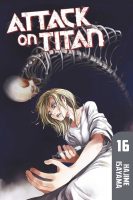My News and Reviews
Since it was the end of one month and the beginning of another, there were a couple of different things posted at Experiments in Manga in addition to the usual My Week in Manga feature. First of all, the Paradise Residence Giveaway Winner was announced along with a list of some manga licensed in English that feature boarding schools, dormitories, or other communal living arrangements. As for the first in-depth manga review of the month, I was absolutely thrilled to write about Shigeru Mizuki’s The Birth of Kitaro, the first volume of Drawn & Quarterly’s new Kitaro series designed to appeal to readers of all ages. I am so incredibly happy that more Kitaro manga is being released in English. I loved Drawn & Quarterly’s original Kitaro collection from back in 2013 (it was one of my most notable releases of the year), but if The Birth of Kitaro is any indication, I’m going to love this series even more.
I’m still keeping plenty busy at home and at work, but there were I couple things in particular that caught my eye online last week. For one, the fourth part of “The Sparkling World of 1970s Shojo Manga,” focusing on Moto Hagio, was posted at The Lobster Dance. Also, Seven Seas made a slew of new licensing announcements over the course of the week. The one that I’m most excited for is The Girl From the Other Side: Siúil, a Rún by Nagabe (coincidentally, Jocelyne Allen recently reviewed the first volume at Brain vs Book and it sounds fantastic), but Seven Seas has also picked up four more yuri manga—Milk Morinaga’s Secret of the Princess and Hana & Hina After School, Hiromi Takashima’s Kase-san and…, and Hachi Ito’s Kindred Spirits on the Roof—as well as Seiju Natsumegu’s Ghost Diary, Tsukasa Saimura’s Tokyo Undead, Kawakami Masaki and Hato’s There’s A Demon Lord on the Floor, and a collaboration with Mamenosuke Fujimaru to create an English-first manga, Captive Hearts of Oz.
Quick Takes
 Attack on Titan, Volumes 16-18 by Hajime Isayama. It’s been a little while since I’ve read Attack on Titan proper as opposed to one of the spinoff manga or novels. Granted, part of that is because the North American release of the manga has more or less caught up with the Japanese release; with number twists and turns in the series’ plot, I find that Attack on Titan generally works better for me if I can read several volumes at once. These three volumes delve into the backstories of several of the characters including Levi and, probably more importantly, Historia. There are also several important reveals regarding the nature of the world and of the Titans. Overall, an exciting few volumes with some legitimately interesting developments. Although the series is still ongoing, it feels as though Isayama is beginning to set up the series’ finale. I’m hoping for a satisfying conclusion, and I’m starting to believe that Isayama might actually be able to pull one off. With the sixteenth volume, Kodansha Comics has also started releasing special editions which are packaged with other merchandise. Some of the extras, like playing cards, I’m not personally interested in but others, like the No Regrets anime, I’m definitely glad to have.
Attack on Titan, Volumes 16-18 by Hajime Isayama. It’s been a little while since I’ve read Attack on Titan proper as opposed to one of the spinoff manga or novels. Granted, part of that is because the North American release of the manga has more or less caught up with the Japanese release; with number twists and turns in the series’ plot, I find that Attack on Titan generally works better for me if I can read several volumes at once. These three volumes delve into the backstories of several of the characters including Levi and, probably more importantly, Historia. There are also several important reveals regarding the nature of the world and of the Titans. Overall, an exciting few volumes with some legitimately interesting developments. Although the series is still ongoing, it feels as though Isayama is beginning to set up the series’ finale. I’m hoping for a satisfying conclusion, and I’m starting to believe that Isayama might actually be able to pull one off. With the sixteenth volume, Kodansha Comics has also started releasing special editions which are packaged with other merchandise. Some of the extras, like playing cards, I’m not personally interested in but others, like the No Regrets anime, I’m definitely glad to have.
 Fairy Tail: Blue Mistral, Volume 2 by Rui Watanabe. Recently, I’ve been sampling quite a few of Fairy Tail‘s spinoff manga being released in English. Some I’ve actually liked while others I’ve merely tolerated, so it was anyone’s guess as to whether or not I’d appreciate the franchise’s shoujo offering, Blue Mistral. I’m happy to say that, for the most part, it’s not a bad series at all. The plot of Blue Mistral, Volume 2 may seem to oversimplify what is really a rather complicated situation and some of story’s resolutions feel like they come a little too easily, but considering that the series original intended audience was preteens and early teens I don’t necessarily consider that to be a true fault. Actually, it’s kind of refreshing to read such a sweet, cheery, and bright version of the world and characters of Fairy Tail. Blue Mistral follows the adventures of Wendy Marvell, an impressively skilled twelve-year-old sky-dragon slayer magic user. She’s a likeable and earnest protagonist who believes in friendship and in helping others whenever she is able. Perhaps unsurprisingly, Blue Mistral‘s shoujo version of Wendy may be even more adorable than Fairy Tail‘s shounen version, in part because Watanabe’s artwork tends to be fairly cute.
Fairy Tail: Blue Mistral, Volume 2 by Rui Watanabe. Recently, I’ve been sampling quite a few of Fairy Tail‘s spinoff manga being released in English. Some I’ve actually liked while others I’ve merely tolerated, so it was anyone’s guess as to whether or not I’d appreciate the franchise’s shoujo offering, Blue Mistral. I’m happy to say that, for the most part, it’s not a bad series at all. The plot of Blue Mistral, Volume 2 may seem to oversimplify what is really a rather complicated situation and some of story’s resolutions feel like they come a little too easily, but considering that the series original intended audience was preteens and early teens I don’t necessarily consider that to be a true fault. Actually, it’s kind of refreshing to read such a sweet, cheery, and bright version of the world and characters of Fairy Tail. Blue Mistral follows the adventures of Wendy Marvell, an impressively skilled twelve-year-old sky-dragon slayer magic user. She’s a likeable and earnest protagonist who believes in friendship and in helping others whenever she is able. Perhaps unsurprisingly, Blue Mistral‘s shoujo version of Wendy may be even more adorable than Fairy Tail‘s shounen version, in part because Watanabe’s artwork tends to be fairly cute.
 Wild Butterfly by Hiroki Kusumoto. It wasn’t until I was about halfway through reading Wild Butterfly that I realized that I had previously read another of Kusumoto’s manga, the first volume of Vampire’s Portrait. I didn’t especially like Vampire’s Portrait (I never got around to reading the second and final volume), but it did have one thing in common with Wild Butterfly—when called upon, Kusumoto can draw some fantastically frightening scenes with shocking reveals. Wild Butterfly is a collection of five unrelated short manga. Despite the fact that, because the volume was released under Digital Manga’s June imprint, “yaoi manga” is emblazoned on the front cover, only one of the five stories could even arguably be considered boys’ love. Most of the stories have a bit of horror or some supernatural elements, although the titular “Wild Butterfly” is more of a period piece about the tragedy of war. There aren’t really any overarching themes in Wild Butterfly, but the stories do tend to be fairly melancholic and somber. The collection isn’t outstanding or particularly refined, but there are some interesting aspects to the stories. I did at least enjoy Wild Butterfly much more than I did the beginning of Vampire’s Portrait.
Wild Butterfly by Hiroki Kusumoto. It wasn’t until I was about halfway through reading Wild Butterfly that I realized that I had previously read another of Kusumoto’s manga, the first volume of Vampire’s Portrait. I didn’t especially like Vampire’s Portrait (I never got around to reading the second and final volume), but it did have one thing in common with Wild Butterfly—when called upon, Kusumoto can draw some fantastically frightening scenes with shocking reveals. Wild Butterfly is a collection of five unrelated short manga. Despite the fact that, because the volume was released under Digital Manga’s June imprint, “yaoi manga” is emblazoned on the front cover, only one of the five stories could even arguably be considered boys’ love. Most of the stories have a bit of horror or some supernatural elements, although the titular “Wild Butterfly” is more of a period piece about the tragedy of war. There aren’t really any overarching themes in Wild Butterfly, but the stories do tend to be fairly melancholic and somber. The collection isn’t outstanding or particularly refined, but there are some interesting aspects to the stories. I did at least enjoy Wild Butterfly much more than I did the beginning of Vampire’s Portrait.